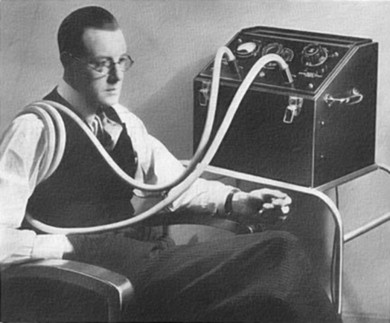Short wave diathermy (SWD), along with many other forms of deep tissue heating, was a hugely popular form of physiotherapy in the middle decades of the 20th century. Dr E. B. Clayton, in his seminal physiotherapy textbooks on electrotherapy and actinotherapy, wrote in 1949 that; ‘At the end of the nineteenth century Tesla and d’Arsonval used high-frequency currents on the human body. A few years later the modified d’Arsonval apparatus, which included an Oudin’s resonator, was in common use. In 1907 Nagelschmidt introduced diathermy’ (Clayton, 1949, p. 218).
SWD turned many physiotherapists into electricians, and textbooks at the time were full of circuit diagrams with filaments, anodes, oscillators, and condensers. SWD was thought to be vital in the treatment of inflammation because it caused heat deep within the tissue that altered local blood flow, but the therapist had to be very careful not to cause burns, shocks, fainting, or other complications of treatment. The treatment was often applied to inflamed joints with large tea-plate sized electrodes, but hose-pipe thick cables, called induction coils, were also used. These induced an electrical field in a long limb — usually the leg — but needed to be arranged with real care so as not to burn the patient’s skin.
Although research is still being conducted into the efficacy of SWD, its popularity has fallen away with physiotherapists’ desire for more active patient management. When it was heavily in use, the size of the machine needed to generate the effect, let alone the effort of the therapist to set it up, must have had at least a significant placebo effect.
Description provided by David Nicholls of New Zealand.
Reference:
Clayton, E. B. (1949). Electrotherapy and actinotherapy. Bailliere, Tindall and Cox.

